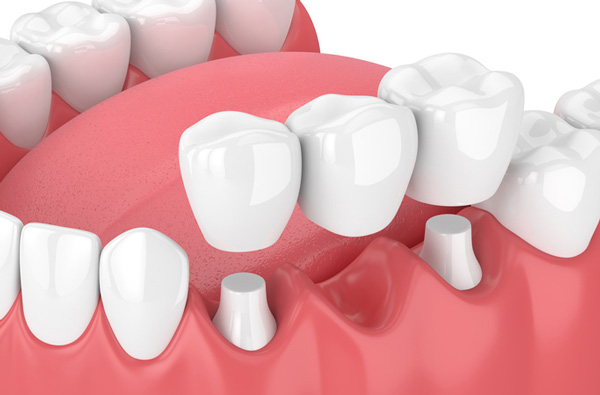How Bridges Use Your Natural Teeth Dental bridges are actually the same as fixed partial dentures. These restorations are used when you have lost multiple teeth together and the loss has formed a large gap in between your natural teeth. It is important for us to fill in this gap so that you can maintain proper functioning and facial structure. Having a gap could easily cause your teeth to shift and the tissues to sink in. Dental bridges utilize your natural teeth to connect to in order to fill the empty space. Dental bridges are actually the same as fixed partial dentures. These restorations are used when you have lost multiple teeth together and the loss has formed a large gap in between your natural teeth. It is important for us to fill in this gap so that you can maintain proper functioning and facial structure. Having a gap could easily cause your teeth to shift and the tissues to sink in. Dental bridges utilize your natural teeth to connect to in order to fill the empty space.At Durham Prosthodontics we will select a specific type of dental bridge based on the best option for your individual case. Types of Dental BridgesYou can select one of four different dental bridges: traditional, cantilever, Maryland, and implant-supported. Traditional bridges are the type used most often. They are preferred for their durable and steady nature. Traditional bridges involve the use of dental crowns, which cap the abutment (connector) teeth, to keep them stable. We do this by filing down some of your enamel on the abutment teeth, placing a dental crown, and then attaching the traditional bridge with dental cement. Dental bridges have a plastic base that acts as artificial gum and artificial teeth that are made of either porcelain or porcelain-fused-to-metal. Maryland bridges are not as durable, but they also allow us to leave all of your enamel intact. These bridges are also referred to as resin-bonded bridges and they are typically used to replace the front teeth. This is because your front teeth do not need to be as sturdy since they are not involved in chewing. Maryland bridges use a support system of metal or porcelain bands, which we bond to the back of the two abutment teeth using composite resin. Cantilever bridges have a similar method to traditional bridges. The main difference is that these only attach to one abutment tooth, rather than two. We still need to remove enamel and place a cap on the abutment tooth. These are slightly less involved than traditional bridges, but they are more prone to damage or shifting. Implant-supported bridges can also be known as fixed partial dentures. These use dental implants, a tool that is surgically implanted into your gum and jawbone. The placement takes a few months to heal from. After you have recovered, we can affix the implant-supported bridge to the implants. Though these involve surgery and the process takes longer than other types of bridges, they are more aesthetically pleasing, durable, and natural-feeling. Procedure Recovery and Bridge MaintenanceYour dental bridge, depending on the specific type and material that we use, should last for approximately five to seven years. You may need to avoid certain foods, especially in the first few days of recovery. These include sticky, hard, and crunchy foods since they could damage the dental bridge. Let us know if you ever experience damage to your bridge. You can follow normal oral hygiene routines to maintain bridges, such as brushing and flossing every day. Some dental bridges, with proper care, have been known to last over 10 years. For more information on dental bridges, call Durham Prosthodontics at (919) 489-8661. |

Contact Information3709 University Dr Suite D Durham, NC 27707-6224 (919) 489-8661 info@mydurhamdentist.com Follow Us |